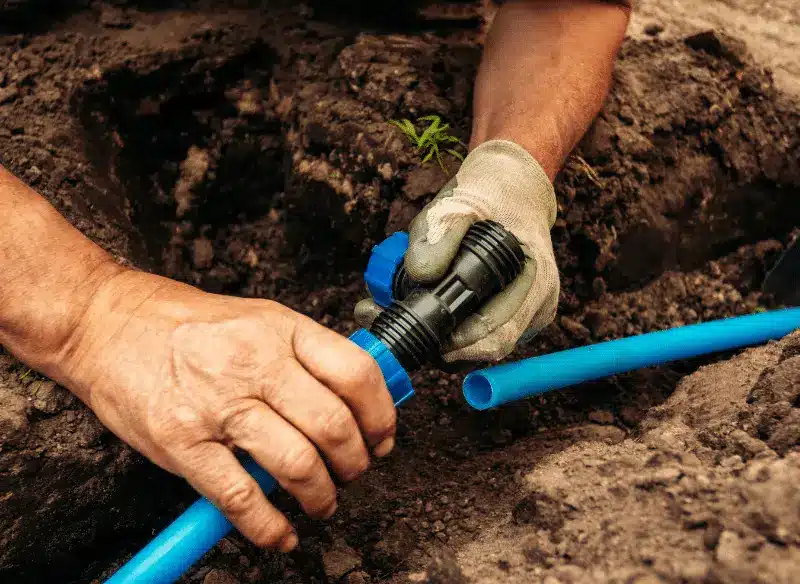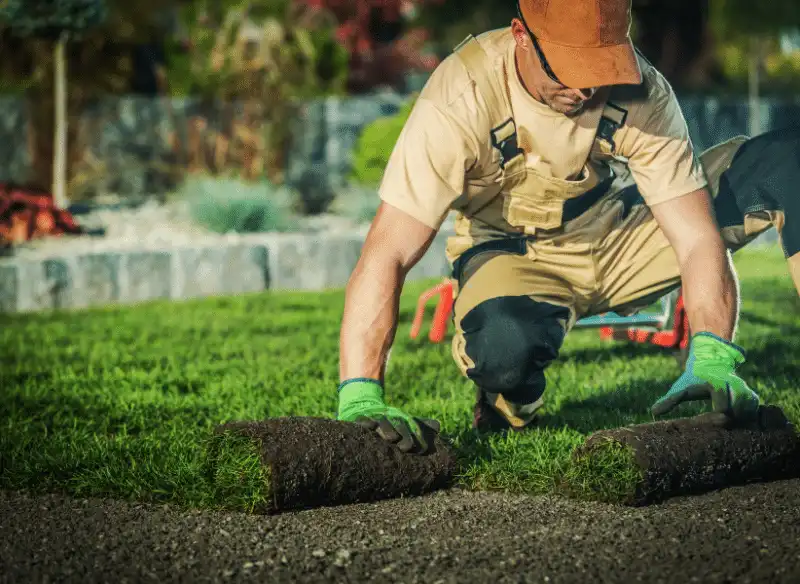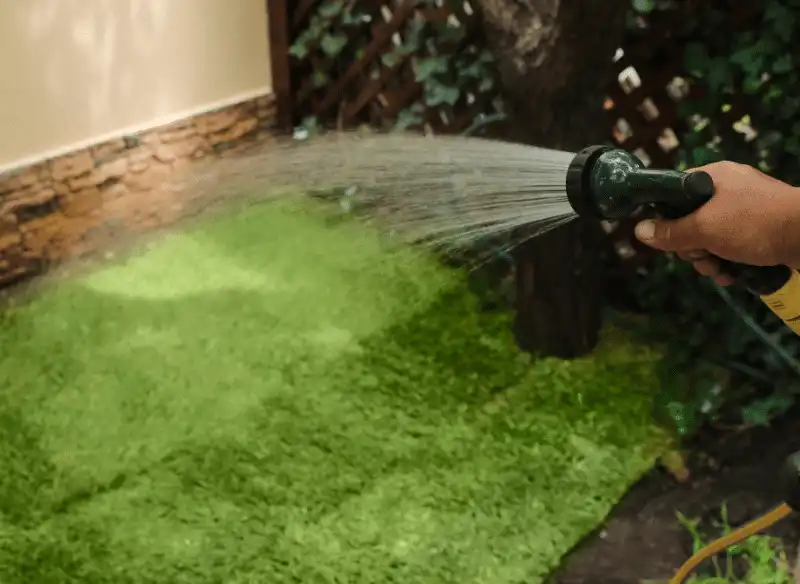The short answer – it depends. But if you’re looking for a quick estimate – the all-in cost can range from about $25 per foot, up to $130 or more per foot.
For example, for a 250 foot long fence, that comes out to about $6250 up to $32,500.
By the way, per foot pricing for fencing is not accurate. For an accurate estimate on pricing you will need to consider multiple factors including:
- Total linear footage
- What type of fence are you going to install?
- What style of fence are you installing and how custom will it be?
- How tall is the fence going to be?
- Are there any heavy slopes?
- Does a retaining wall or footer need to be installed for the fence?
- What does the jobsite access look like?
- How many gates do you need?
- Do you need any custom or large gates?
- What type of installer are you going to hire?
1. Total Linear Footage
The length of the fence is the most obvious cost factor. The longer the fence, the more it will cost. However, you will more than likely get a better cost per foot the longer the fence is.
Let’s do an example – and let’s assume you’re hiring a large established fencing company to install the fence (more on which type of installer is best for you later):
And let’s say the fence below is what you’re having installed (8 ft board on board prestained western red cedar with boxed-in steel posts). Yes, we’re going fancy on this first example, so make sure you’re sitting down for this one.
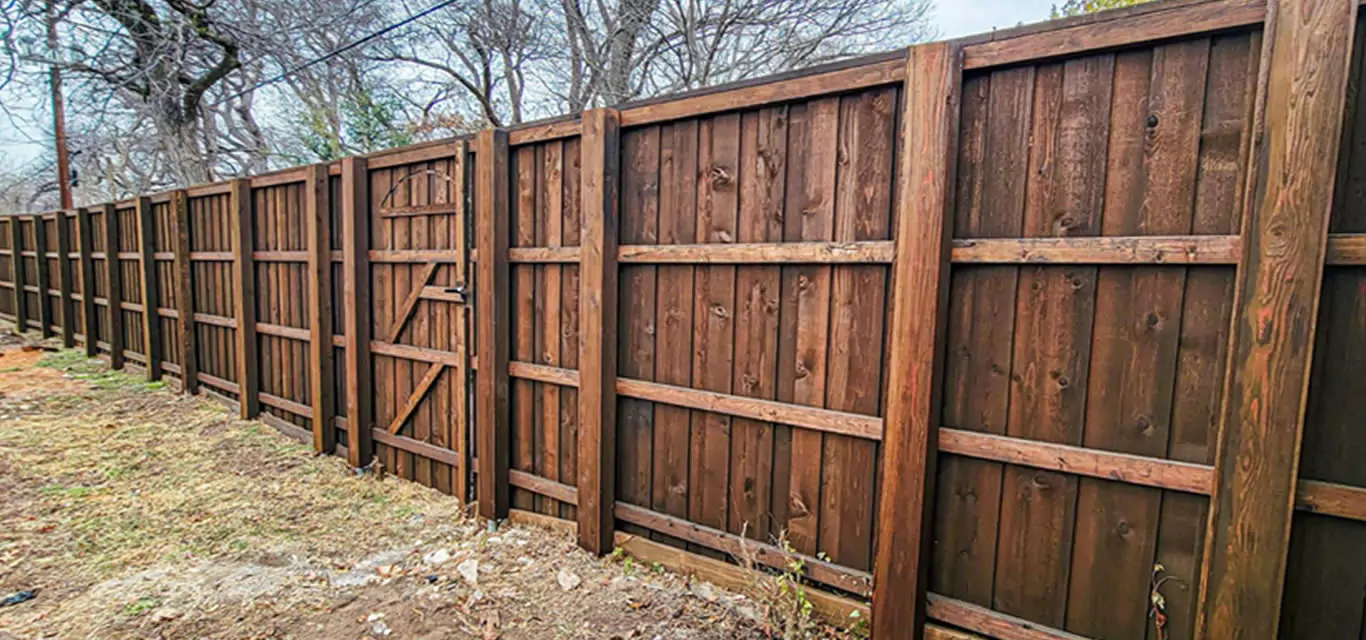
Let’s assume it’s 200 feet long, and it’s a simple install with nothing that would increase the install price.
Something like this could run anywhere from $20,000 to $27,000. Let’s call it $24,000. That comes out to $120/ft .
However, let’s say you’re only installing 50 feet of this type of fence. The total would now be something closer to $7,000, or $140/ft.
And let’s say you’re getting only 20 feet installed. Well then they might have to charge something closer to $4000 or $200/ft.
This is just an example on how the total linear footage can affect pricing. Typically the more linear feet, the better deal you will get. Some companies will have minimums for the total linear footage to protect their time and to protect your pocket.
When getting pricing, expect a price based on the total linear footage, and don’t just go based on a per foot price for the most accurate quote.
2. What type of fence are you going to install?
How does fence material affect cost?
There are many types of fences and materials that can be used, but the most common will be wood, wrought iron style (aluminum or ornamental), vinyl, Chain link, and composite. More on the different fence types here:
Not only does the fence material itself affect the cost, but the install practices and style of fence needed for each affects it as well. In general, Vinyl and Composite are going to have the highest initial cost for material and installation. Wood can get up there too if you select premium wood and extravagant build design. Wood can also be one of the most economic options if you choose more budget friendly materials and design specs.
In general, here’s the ranking of fence types from most economic to most expensive:
1
Chain link
2
Wood
3
Wrought Iron
4
Vinyl
5
Composite
Obviously these rankings can move around based on exact material and design specs but this is a good list to start. Below we’ll put a chart showing each fence type and a range of how much it will be for a simple flat ground install.
Also remember that the type of installer you hire will GREATLY affect installation price as well. More on that later. Below we’ll do a general price range assuming you’re using a reputable installer.
We’ll include the total cost AND the per linear foot price, but DO NOT RELY ON PER FOOT PRICING! We’re including it so that you can use it as a reference, but a per foot price is not accurate.
Let’s assume it’s 200 feet long of fence again:
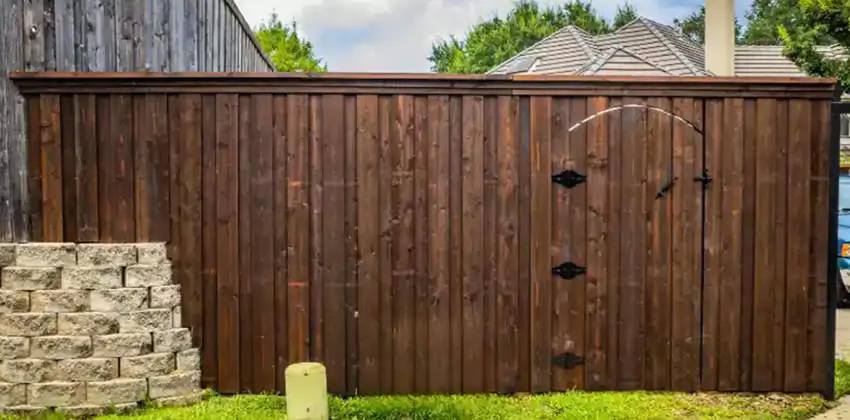
FENCE TYPE
8 ft Premium Wooden Fencing
MATERIALS AND INSTALLATION PRICE RANGE
$16,000 to $28,000 +
$80/ft to $140/ft
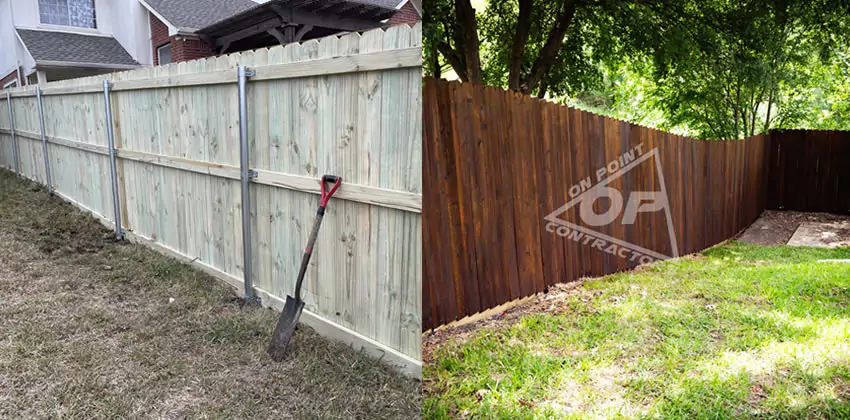
FENCE TYPE
6 ft Economic Wooden fencing
MATERIALS AND INSTALLATION PRICE RANGE
$7,000 to $12,000
$35/ft to $60/ft

FENCE TYPE
4 ft to 8 ft Wrought Iron Style
MATERIALS AND INSTALLATION PRICE RANGE
$7,000 to $24,000 +
$35/ft to $120/ft+
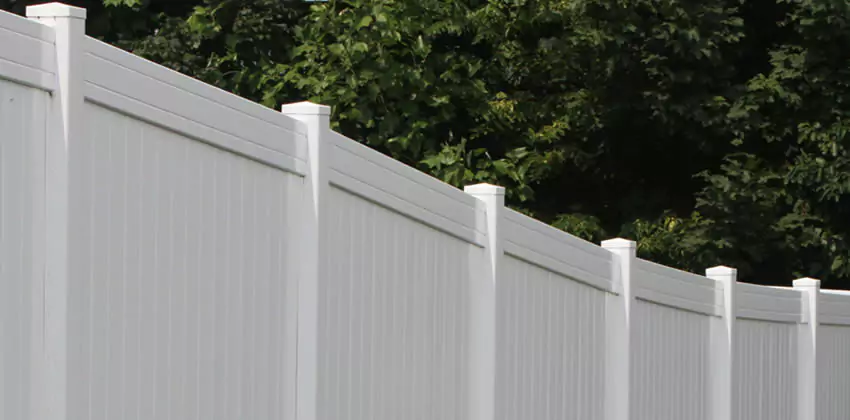
FENCE TYPE
6 ft to 8 ft Vinyl
MATERIALS AND INSTALLATION PRICE RANGE
$10,000 to $30,000 +
$50/ft to $150/ft +
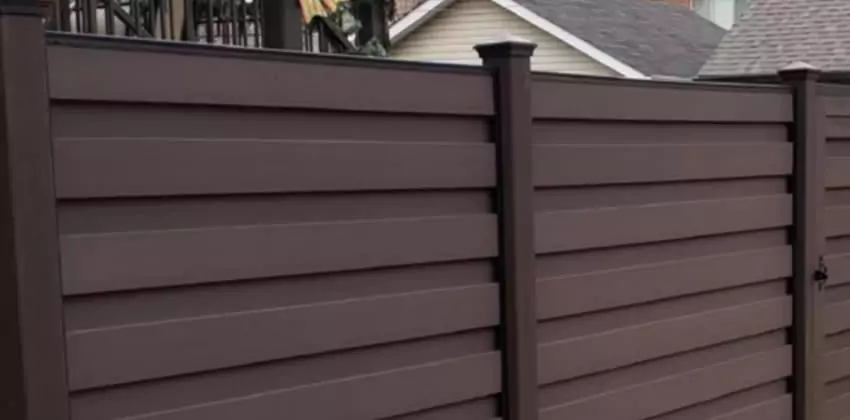
FENCE TYPE
6 ft to 8 ft Composite
MATERIALS AND INSTALLATION PRICE RANGE
$13,000 to $38,000 +
$65/ft to $190/ft +
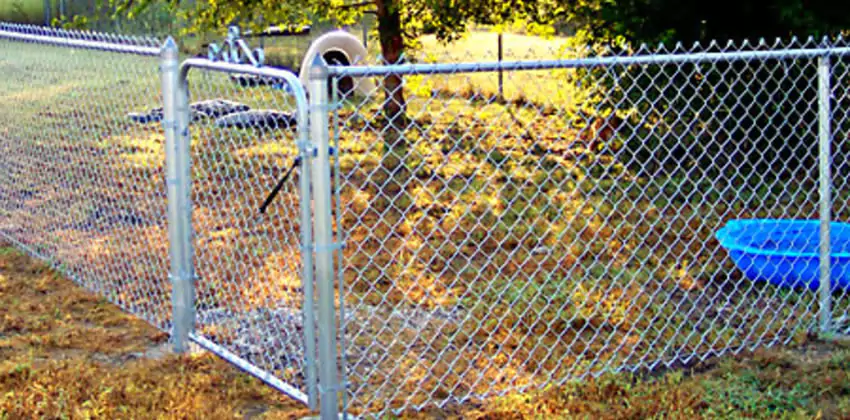
FENCE TYPE
4 ft to 6 ft Chain Link
MATERIALS AND INSTALLATION PRICE RANGE
$3000 to $8000
$15/ft to $40/ft
All of this information can be a bit daunting. So let’s simplify it a little.
Here’s the price range of each fence type from the economic to the premium version of each one:
We’ll assume 6ft to 8 ft tall fencing, and 200 linear feet –
Chain link
$7k to $28k+ or
$35/ft to $140/ft+
Wood
$10k to $24k+ or
$50/ft to $120/ft+
Wrought Iron
$4k to $15k+ or
$20/ft to $75/ft+
Vinyl
$10k to $30k+ or
$50/ft to $150/ft
Composite
$13k to $38k+ or
$65/ft to $190/ft+
3. How does fence height affect price?
The taller the fence the more material and labor you will need. Also keep in mind that a taller fence will also need more support – especially if it’s solid fencing where wind can’t pass through.
With a taller fence, here are the things that cause the price to go up
Deeper Post Holes:
This means more labor on digging the holes. This helps anchor the fence into the ground. Example: in texas, a 6 ft tall fence should have posts dug at least 2 ft into the ground, and for an 8 ft tall fence, at least 3 ft into the ground.
More Concrete:
Because the hole is deeper, more concrete is needed (if using concrete).
Taller Posts:
Because of the extra height of the fence, and the extra depth of the holes, you need longer posts. This obviously costs more.
Thicker Posts:
A thicker gauge post should be used when increasing fence height. This will prevent the posts from bending due to the extra horizontal forces applied to the fence (usually wind).
Closer Post Spacing:
Posts are installed more closely together to increase strength. Example: for 6 ft tall fencing, posts are spaced at most 8 ft apart. For 8 ft tall wooden fencing, posts should be placed at most 6 ft apart.
More Fence Material:
This one is obvious – the taller fencing means you will need more of whatever material it is you are using. This often includes more framing and taller pickets for wood fences, or larger panels for wrought iron style.
MORE LABOR:
With all of the above considered, much more labor is required to install a taller fence. Taller fences may require ladders to reach the top and this can add a lot of time and difficulty to installation.
Here’s an example of the difference in price that the height can cause. Below to the left is a 6 ft tall fence. To the right is the same specs and build, but 8 ft tall.
At 170 ft, the homeowner on the left spent about $10,400. The homeowner on the right spent $16,900 for the same 170 ft in length.

That’s over 1.6 times the amount for an additional 2 ft in height!
4. How does the slope affect fence price?
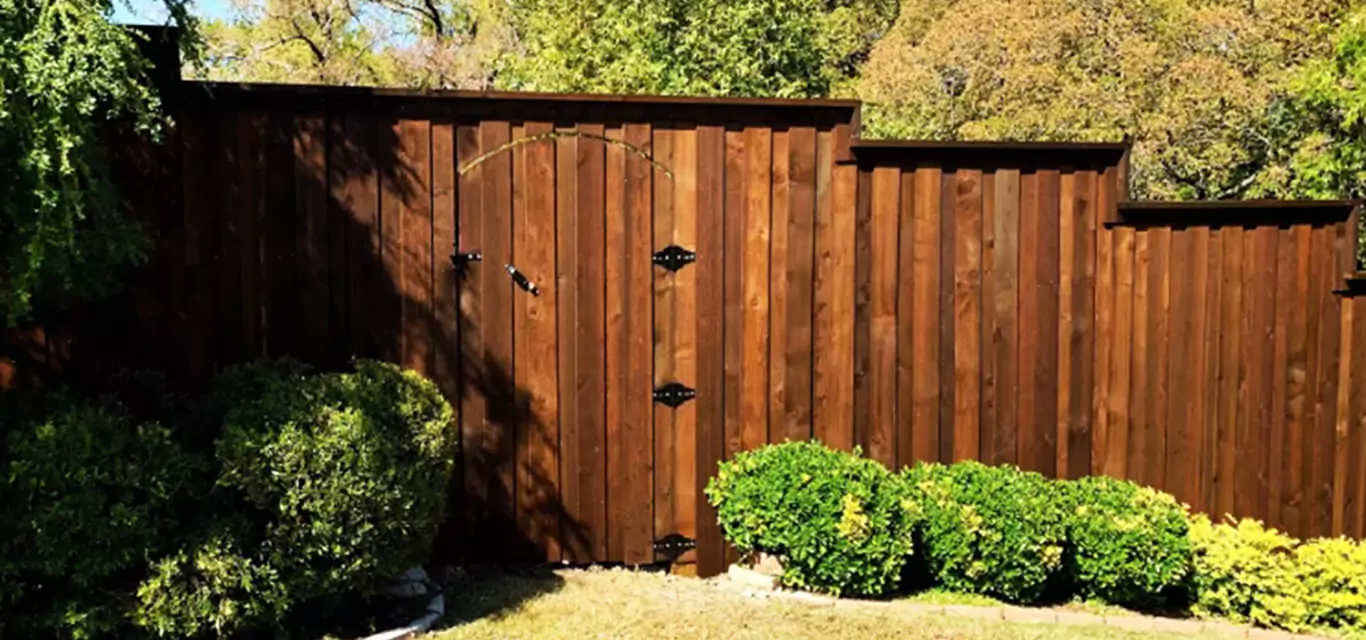
The step-down! Above is a picture of a fence that was installed on a slope. The fence goes down the slope in a stair-like fashion, called a “step-down”.

Depending on how steep the slope is, this can cause the need for more rails, more posts, more panels, rackable panels if installing wrought iron style, extra hardware, and more attention and time to make sure the fence is installed correctly.
You may need longer posts too. Longer posts may be needed to accommodate for the changes in elevation.
Other things to consider with slopes: the potential for erosion around the base of the posts, How the water will drain and how that will affect the way the fence needs to be built, and if you need a retaining wall.
5. Do you need a retaining wall for your fence?
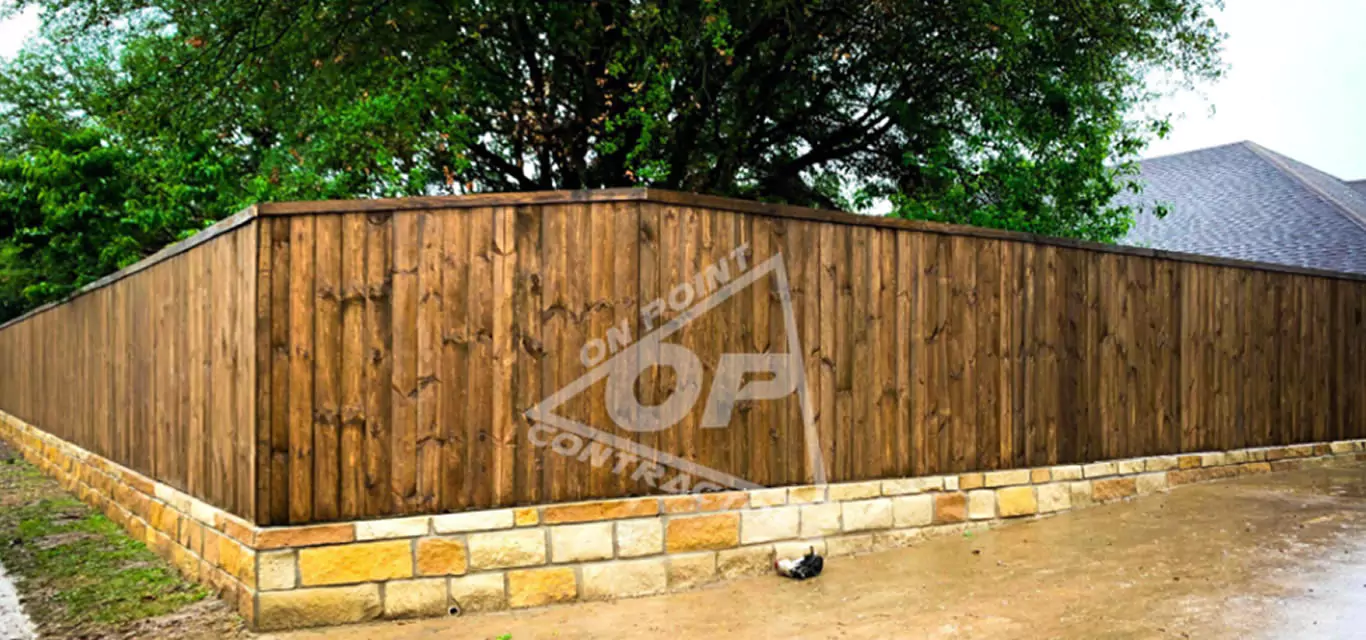
If you need a retaining wall for your fence, this can significantly add to the cost, especially if you’re installing a decorative stone fence like the one shown above (oklahoma stone).
You could also get a more economic wall like the one below (treated pine wall with support posts).
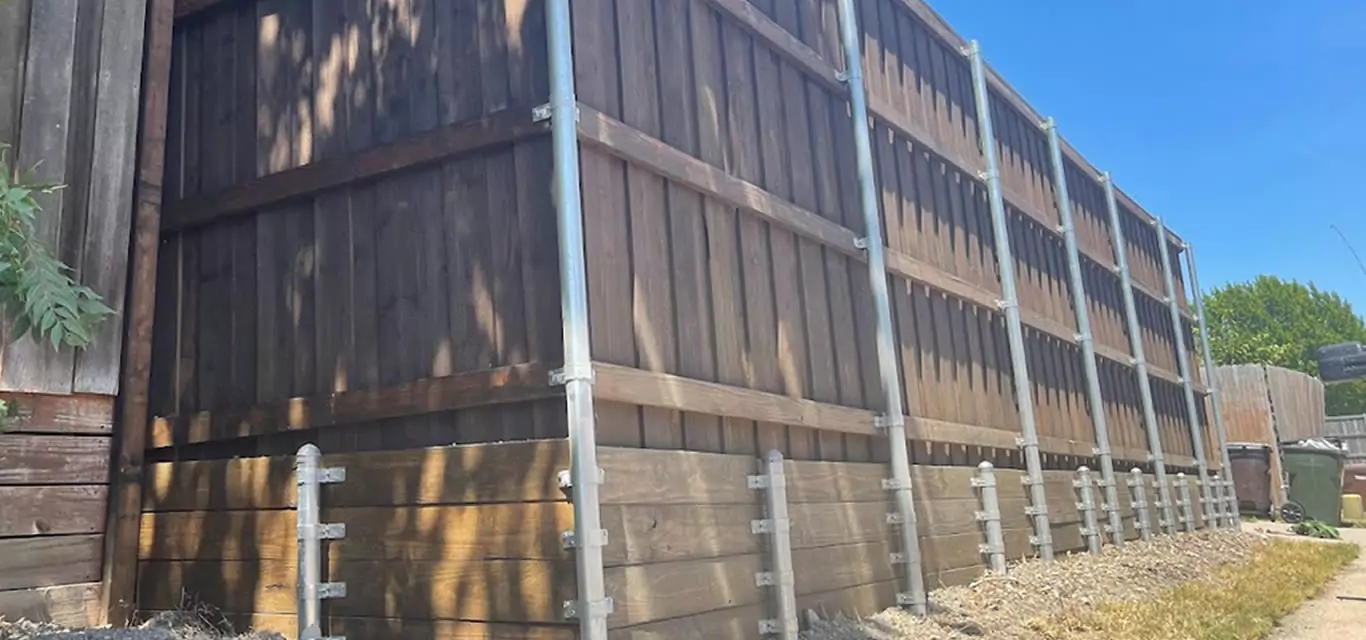
There are many reasons you could need a wall, but the main ones are these:
You need to hold in soil, typically for a raised yard or pool.
Aesthetic purposes:
You want to add to the look of your fence.
Keeping things in / out.
You want to keep pets inside the fence and deter them from digging under the fence, and you want to keep other animals or critters out.
Height limit work-around:
Your city or HOA may limit the height of your fence. But with a retaining wall you can sometimes work around these restrictions to add the height you want.
Example: on a 200 ft fence, a wall can add anywhere from $6000 to $25,000 or much, much more. If you are getting the wall for only a portion of the fence, like just the back side, then this can help bring the additional cost down.
Expect anywhere from $30/ft to $125/ft or much more (remember, per foot pricing is not accurate, just a guideline).
When do you need an engineer for your retaining wall?
In most jurisdictions, anything over 4 ft in height will require a structural engineer’s involvement.
There’s other reasons to get an engineer involved too, like if you have really poor soil conditions, the wall is near a structure or a dynamic load, if there’s water or drainage issues, and more.
If you have to get an engineer involved, expect your wall price to go up significantly.
6. What does the jobsite access look like?
If you have limited access to where the fence is going to be installed, expect there to be an added labor cost to installing the fence.
Here are the conditions to look out for when assessing if your jobsite has good access:
Proximity to the Road:
The closer the jobsite is to a public road, the easier it is to access.
Slope:
Flat ground is easier to access and work than sloped ground. Steep slopes may require special equipment or special methods to transport materials.
Soil Stability:
Unstable ground can make it difficult to use vehicles and equipment. Example: your soil tends to always be very muddy.
Access Points:
What are the access points to the site and what are the widths? Are the access points in convenient locations and are they wide enough for any necessary equipment?
Vegetation and Trees:
Dense vegetation, trees, bushes, etc can make it impossible to install fence. These will need to be removed before installation.
Utility Lines and Pipes:
Overhead power lines and underground utilities can restrict where the fence can be installed. This may cause the need for work-arounds.
Existing Structures:
Consider any existing sheds, buildings, or other structures that could be in the way.
7. How many gates do you need?
This one is pretty simple. Gates take more materials and labor to install. The more gates you need, the more you should expect the cost to go up.
Usually about $300 to $800 per 4 ft wide walk-gate.
8. Do you need any custom or large gates?
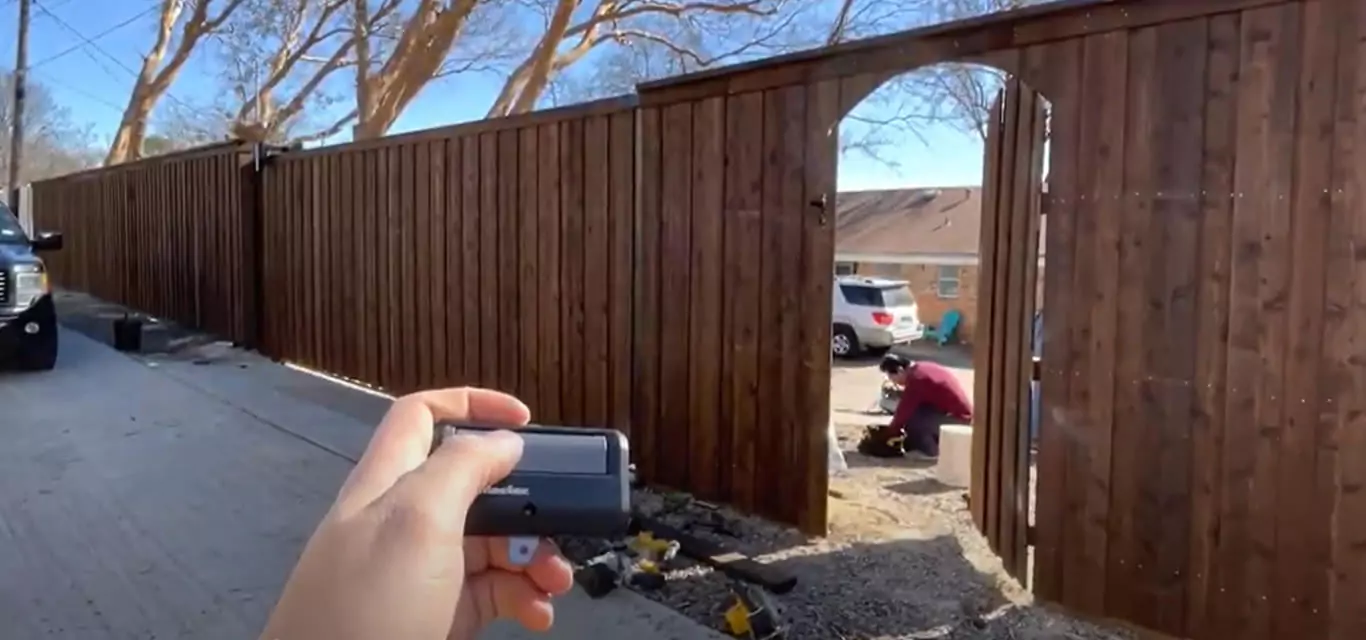
Are you closing off your driveway? Are you adding a vehicle access gate to your backyard?
You may need a custom large gate. This will typically be either a sliding gate, a single swing gate, or a double swing gate – and it will be either automatic (Solar or hardwired), or manual.
Automatic gates from 15 ft to 30 ft wide will range from $8,000 to $15,000 or more.
Manual gates will typically be almost half of that, around $4000 to $8000. Sometimes you can get a manual gate for even lower, especially if the width is closer to the 8ft to 12 ft width.
Click here for a full breakdown on what a large vehicle access gate costs.
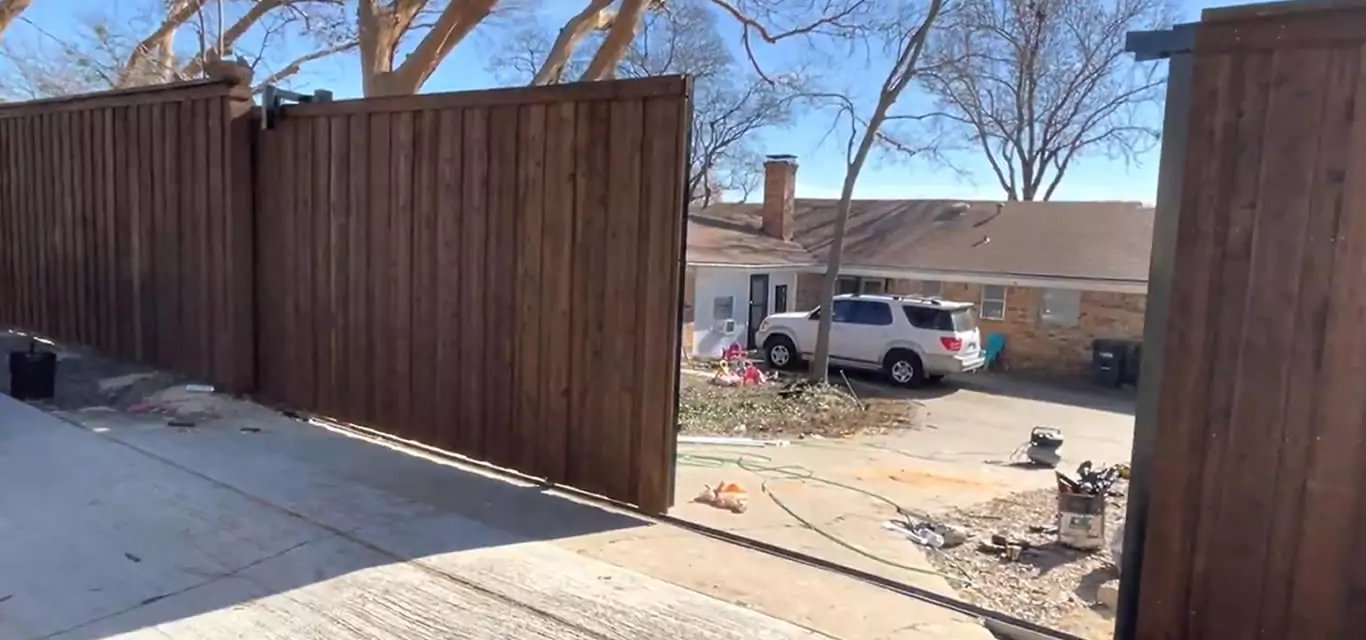
A large cost involved with automatic gates is going to be the motor. Make sure your installer isn’t cheaping out and getting you a low quality motor. This happens very often.
A good motor to go with is a Liftmaster CSL (commercial grade) or HDSL (Heavy Duty). The RSL (Residential) is good too, but make sure the weight of your slide gate isn’t too heavy if using an RSL. For example, an RSL could be used for most aluminum gates, vinyl, or a short width wooden gate (up to 12 ft or so).
It’s never a bad idea to spend more on a more robust motor so that you won’t have problems in the future. It is very common that installers will put motors in that have nowhere near the required specs.
Make sure to get the specific motor and model number that your installer will be using, and do your research to make sure it’s the right one.
There’s other factors that go into the cost of the sliding gate as well, like the security accessories that should be installed (another thing that many installers skip out on or install incorrectly). EX. Security bumper and sensors. For sliding gates – the type of slide track used (silver is a good option for the track because it’s resistant to rusting). There’s the support posts, the roller support, and the steel framing.
We’ll dive more into large gates here.
And finally, the last and maybe the most important factor that determines how much your fence will cost:
9. What type of installer are you going to hire for your fence?
There are many different types of fence installers. Let’s break it down into a spectrum. At one end, you will need to spend more time and effort, and at the other end you will need to spend more money in exchange for time and peace of mind.
At the start, you’ve got yourself. This is the DIYer (do-it-yourself-er). This is the most economic option, but requires the most effort and time.
DIY
Owner Operator
Established Company
As you go toward the middle, you’ve got your owner-operators. These people are either a one man show (like a handyman), or they have a small company and usually no more than one crew that they themselves lead. Either way, the owner-operator type of installer will not only own their own business, but are on the tools themselves as well.
In the middle of the spectrum with an owner-operator type of installer, you can get a quality installation done. However, there is some risk.
Oftentimes these smaller companies don’t have much of an online presence (this can be a problem when trying to reach back out to them for warranty work). They might not be specialized in fencing since they may need to take as much work as possible to keep the schedule full. They may be multitasking too much since they have to balance running a business and building fences. Another risk is that oftentimes they don’t have the proper insurance or workers compensation to protect you, the homeowner, if something happens.
And finally, warranties or call-backs can financially hurt a smaller business or owner-operator, so they may not be able to stand behind their work.
With all of this said, there are definitely good owner-operators out there. In fact, that’s most of the fencing industry. You can get a good installation done at a lesser price with this type of company (although possibly a higher price if they don’t know how to properly estimate projects).
Just make sure to do your due diligence with a smaller owner-operator type installer. You don’t want to be that person who has their contractor “run off with your deposit”.
And to the right of the spectrum, you’ve got your larger, more established fencing company. The owner/ owners of this company are not in the field. You might not even know who they are.
These businesses have dedicated install crews and crew leaders, project managers, estimators, office managers, and maybe a CEO. These companies typically have multiple hundreds of reviews online and might be well known in your area.
These Established fencing companies will almost always be the highest priced. The trade-off is that the entire process from reaching out to getting your fence installed will be CONVENIENT and EASY. You will have the peace of mind knowing that no matter what happens, the company will make it right.
But, of course there are instances of larger fence companies not doing right by the homeowner. Again, make sure to do your due diligence when choosing your installer.
So how does the company you choose affect pricing?
Let’s say your getting this type of fence installed:
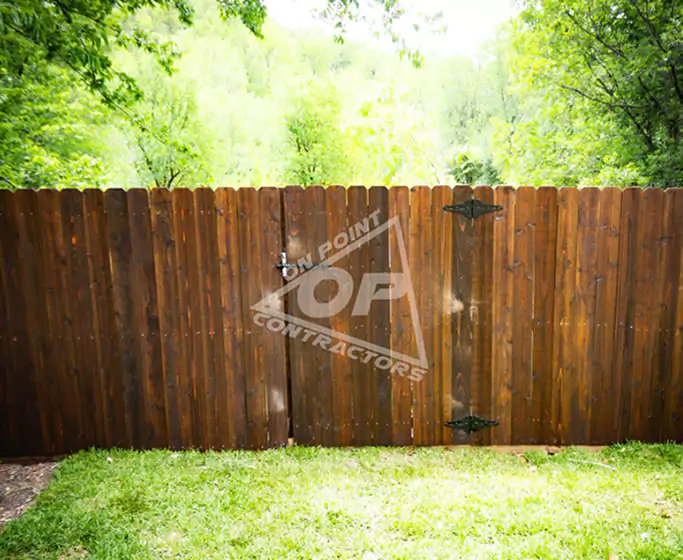

And let’s again say it’s 200 ft of fence. Here’s how the pricing might look depending on who you hire.
DIY: Total price: $3,300 to $4,500
Owner-Operator: $5,000 to $9,000
Established Company: $9,000 to $13,000
So there you have it – that’s how much a fence costs. Hopefully all of this helped!
If you need a quote, click here
To calculate how much your fence will cost, click here.


